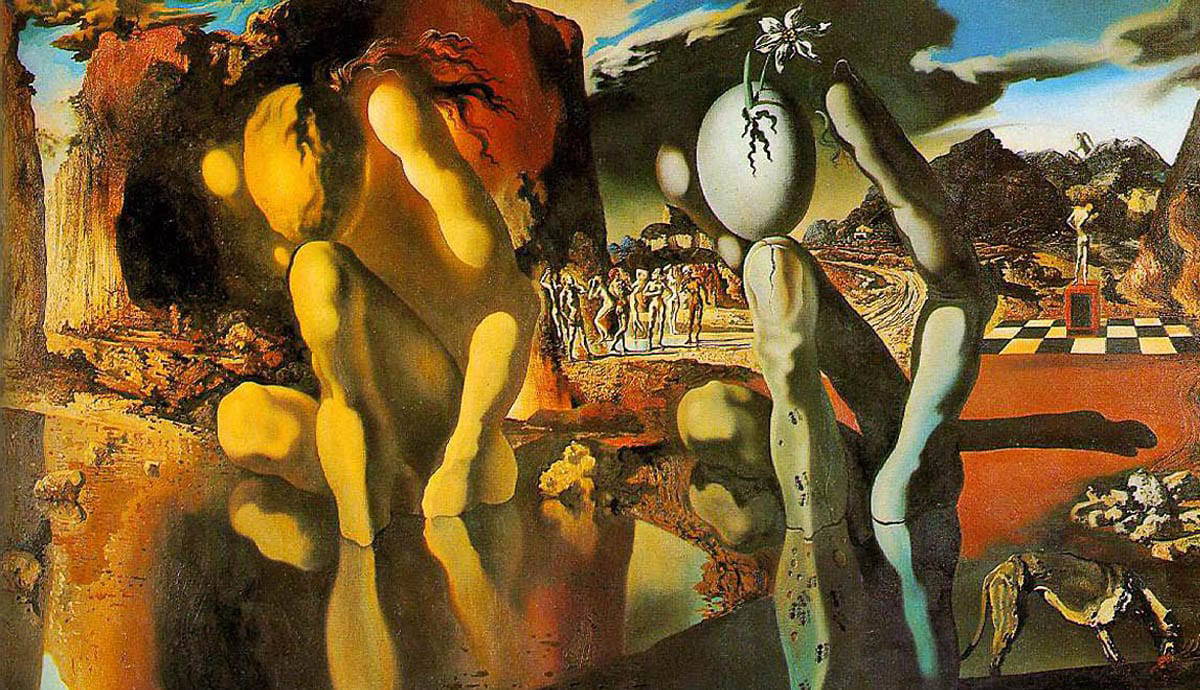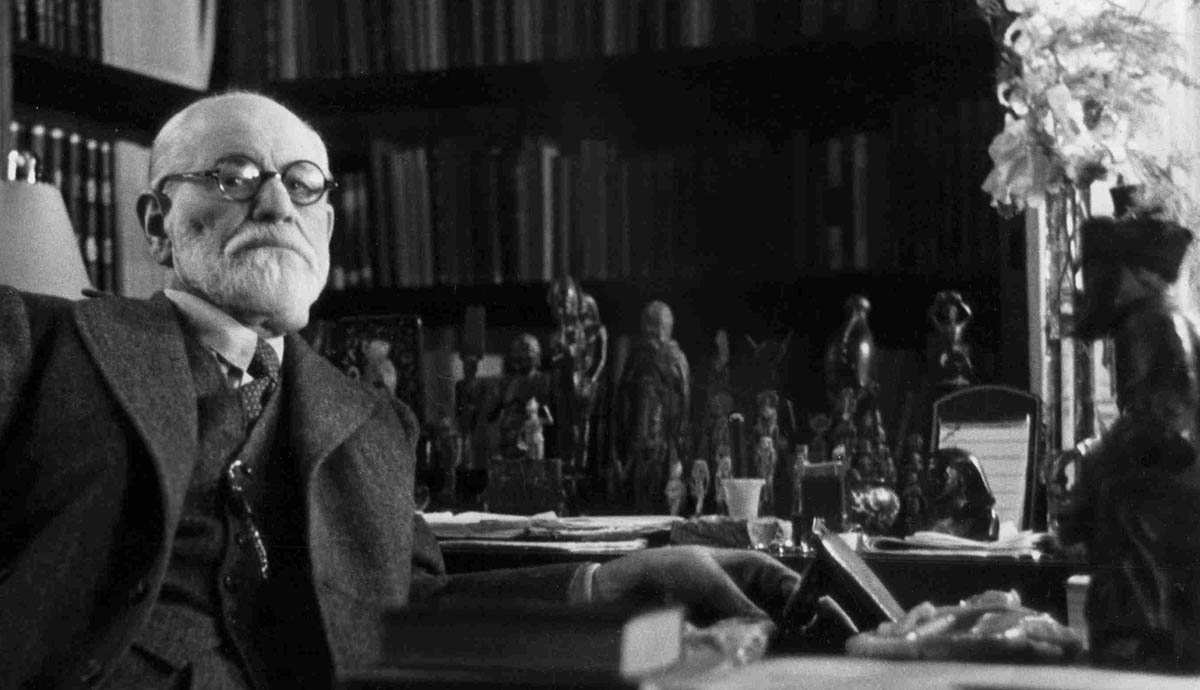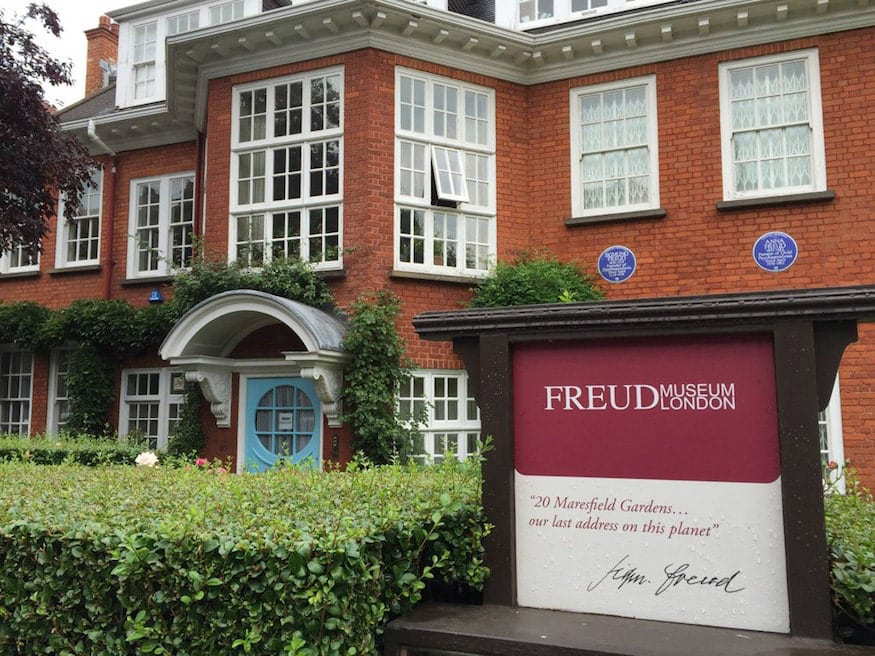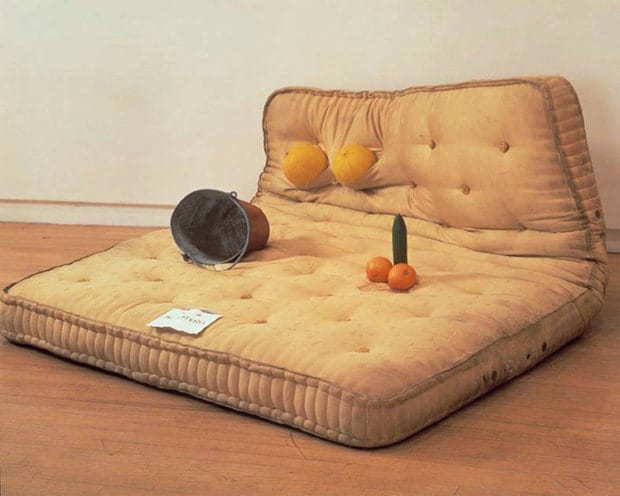The Art Movement That Based Its Work on the Psychoanalytic Theories of Sigmund Freud Was

Widely recognised as the "father of psychoanalysis", Austrian neurologist Sigmund Freud forever altered the way we see ourselves. Assertive our developed behaviour is driven by repressed childhood experiences of love, loss, sexuality and death, he wrote extensively on the discipline, as well as practicing psychoanalytical therapy with many patients in distress. Nowadays, most of Freud's ideas take mostly been replaced by a more than rational, scientific approach to homo psychology. But within the arts, the creativity and inventiveness of Sigmund Freud's theories continue to fascinate and inspire countless creative thinkers.
Sigmund Freud'southward Part In The Arts

Freud's involvement with the arts during his lifetime included several strands of activity. He wrote extensively nearly the lives and personalities of artists, particularly those from the Renaissance. Freud was also an avid fine art collector. Throughout his life, he amassed a vast annal of over 2,500 antiquities from ancient civilisations around the earth. He displayed his collection in his abode function in Vienna, and later in London. Such was the extent of his collection, that his London home was converted into the Freud Museum in 1986, to showcase his impressive archive to the world.
Although Freud'due south personal preference was for ancient art, his psychoanalytical theories had a lasting influence on the early xx th century avant-garde. As artists moved increasingly beyond the visible world into explorations of the individual human mind, Freud's theories encapsulated the spirit of the times, and his techniques of dream assay and free clan had a particularly profound touch on on the international Surrealist movement. Even today, artists continue to find fertile source material in Freud's fascinating theories, while his grandson, Lucian Freud , is one of the 21 st century's most pop painters.
Sigmund Freud's Writings on Art

Freud was fascinated by art. Dissecting the minds of creative thinkers became an important strand of his practice as a author, allowing him to search for the deeper drives that compelled these artistic geniuses. He wrote analytical essays on individual artworks, including The Moses of Michelangelo, and even published an entire volume on Leonardo da Vinci, titled Leonardo Da Vinci and a Memory of his Childhood, 1910, exploring the artist'south childhood, sexuality and how it came to inform his art every bit an developed. Although Freud was sometimes criticised for bringing likewise much autobiographical content into his art essays, the way he intrinsically linked artists' lives with their piece of work has undoubtedly shaped the fashion we understand art today.
Are you enjoying this article?
Sign upwards to our Free Weekly Newsletter
Delight bank check your inbox to actuate your subscription
Thank you lot!
Another fascinating theory Freud developed around fine art was his concept of "ideational mimetics." He argued an artwork could cause a powerful exchange of free energy between viewer and work of fine art, like to the experience of empathy. Freud argued this experience was a fundamental part of life in higher level culture, revealing how important he saw the part of art in society.
An Astonishing Art Collection

In 1986, Freud's London home was converted into an fine art museum, showcasing to the world the extent of his vast fine art drove. One hundred years earlier, in 1896, the young Freud was still living in Vienna, while his male parent had just passed away. During this menstruum of dramatic upheaval and re-evaluation, he began collecting art objects. Still relatively unknown and with a limited income, Freud's earliest purchases were plaster replicas of Italian Renaissance artworks . Only as his career flourished in the years that followed, Freud's collection became increasingly diverse and adventurous. He developed a particular taste for rare antiquities, seeing in aboriginal civilisations intrinsic meanings about human society, which in plough came to inform much of his writing and theories. Many of his art objects were bought from Vienna's markets, originating from ancient kingdoms effectually the world, including Egypt, Greece, Rome, India, Mainland china and Etruria.

Freud displayed this astonishing collection in his Vienna office, and later in London, when forced to run from Nazis during the Second Earth War. On the walls, they were arranged in an eclectic, haphazard mode, as Bryony Davies, assistant curator at the Freud Museum points out: "Freud'southward own brandish style was personal … his objects announced in his own unique mode." On his desk, he had his smallest and near precious objects laid out, which he was said to enjoy touching, or even carrying effectually with him while he was working, while cabinets were packed with objects bundled into groupings including Greek vessels and Eros statues. Freud had a particular fascination with two faced figures, which characteristic prominently in his collection, and reflect his theories on dualisms, such as pleasure/reality, life/death, and conscious/subconscious.
Freud's statuette of Athena, the goddess of wisdom and state of war, was i of his most prized possessions, which he would sit down on the middle of his writing desk. A copy of a Greek original, Freud's version most likely dates from the 1 st or 2 nd century A.D. Freud smuggled Athena with him when he fled from Austria to London post-obit the Nazi invasions of the 2nd Earth War, and she all the same sits proudly on the desk-bound of his London Museum today.
Sigmund Freud's Bear upon on Surrealism

Freud's theories had a particularly profound bear upon on the Surrealist Movement of the early 20 thursday century. They, in turn, brought his ideas into the public heart, making him more than popular than ever. His iconic text, The Estimation of Dreams, 1899, was particularly important to Surrealist artists. Connecting with Freud'due south belief that dreams could reveal hidden meanings about our innermost desires, which were ofttimes erotic or sexualised, the Surrealists discovered and pioneered a wide range of techniques, unleashing the wondrously circuitous, unconscious world of dreams into their art.

Many Surrealists adopted Freud's techniques of gratis clan and automatic cartoon, working in a fashion that they believed could release unconscious thoughts. These included automatic writing without forethought, or cartoon and painting with free flowing, improvised methods, as seen in the freewheeling line drawings of Paul Klee and Joan Miro . Max Ernst also made rubbings, scrapings and collages that relied on chance, play and accident. Collage was a popular technique that allowed artists to work rapidly, combining images from clashing sources in strange and unexpected ways. French poet Andre Breton , who led the Parisian Surrealist group, called these ideas, "Idea expressed in the absence of any command exerted past reason, and outside all moral and aesthetic considerations." These ideas, in plough, shaped the intuitive fine art of the American Abstract Expressionists in the 1950s, including Willem de Kooning and Jackson Pollock .

Some Surrealists took inspiration from their ain dreams and nightmares to invoke a Freudian world, creating startlingly life-like depictions of a strange, alternate reality. In Dorothea Tanning's Eine Kleine Nachtmusik, 1943, a domestic scene turns into a horrific nightmare, while in Salvador Dali'due south foreign, mystical landscapes, objects are stretched, distorted and turned into monstrous beings. Dali claimed his imagery came from his visionary dreams, which he would see simply as he was falling asleep, calling this phase "the slumber with a fundamental."

Freud's essay on The Uncanny, published in 1919, as well had a lasting affect on Surrealist art. Freud argued that "the uncanny" was a translation of something once familiar into the haunting and agonizing, making it strangely familiar, such as eerie dolls coming to life, doppelgangers, or mirrors and shadows. These theories proved immensely popular with artists working in a broad range of media, including sculpture, photography and picture show. In the wake of the Starting time World War, Freud'southward theories on the uncanny had particularly jarring resonance with many, because the in one case ordinary and familiar had been transformed into the fearful and menacing. Hans Bellmer'south haunting dolls took on this uncanny quality, equally did Man Ray'south transformation of a flat iron into a weapon in Cadeau, 1921.

Freud was said to exist somewhat bemused and baffled when, as he wrote, "the Surrealists take apparently called me as their patron saint." Unimpressed past much of their art, he argued their attempts to create the illusion of automatic thought and dream-like imagery were as well self-conscious and driven past ego to be convincing.
Sigmund Freud'southward Theories And Its Influence In Art Today

The Surrealists did much to popularize Freud's theories in the modern and contemporary art earth. One of the almost prominent artists to follow on their legacy was the French sculptor Louise Bourgeois. She argued the all-time fine art of the xx th century had a confessional, autobiographical element and was "a course of psychoanalysis." Citing her own troubled childhood equally the inspiration for much of her art, she regularly underwent psychoanalysis iv times a week for most of her adult life. Her artworks are brimming with sexual innuendo, and make reference to Freud'due south theories on gender, particularly his belief that nosotros have both male person and female person aspects to our identity. Janus Fleuri, 1968, has a ii-function, hybrid sexuality, and the horrifyingly graphic The Destruction of the Father, 1974, envisions her destroying her father in a truly Freudian scenario.

Many of the Young British Artists in the 1990s played with Freud'due south theories, particularly the British sculptor Sarah Lucas. Reimagining Freud'due south concept of the uncanny with a cheeky, laddish camber, her famous installation Au Naturel, 1994, transforms seemingly banal, constitute objects into an arrangement loaded with crude sexual references. Other works draw on the lewd sexual languages of Hans Bellmer and Louise Bourgeois , made from stuffed tights filled with cream, which become lumpy or dangling mutations resembling both male and female trunk parts.

Alongside Freud's own extensive art collection, The Freud Museum stages regular solo and group displays, likewise as commissioning site specific projects, which reveal the psychoanalyst's long-lasting influence on contemporary fine art practices. To gloat 100 years since the publication of The Uncanny, in 2019 the Freud museum staged The Uncanny: A Centenary, featuring artworks by Hans Bellmer alongside gimmicky practitioners, including Elizabeth Dearnley, Martha Todd and Karolina Urbaniak; this display revealed how Freud's endlessly recyclable theories continue to ignite sparks of inspiration in the adjacent generation.
carusowastive1990.blogspot.com
Source: https://www.thecollector.com/sigmund-freud-theories/
0 Response to "The Art Movement That Based Its Work on the Psychoanalytic Theories of Sigmund Freud Was"
Post a Comment